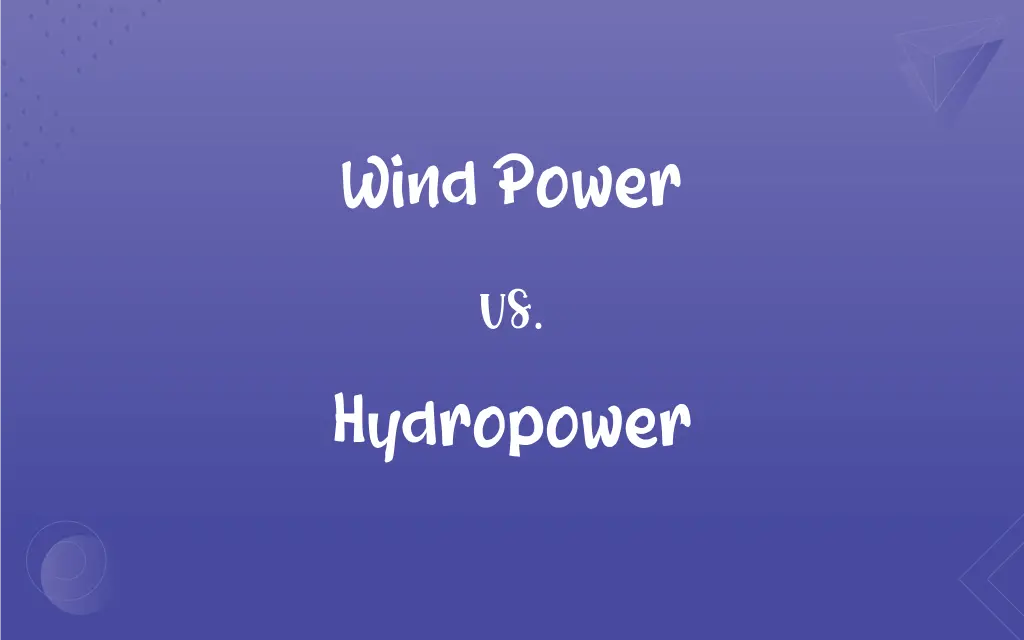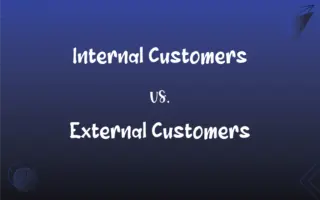Wind Power vs. Hydropower: What's the Difference?
Edited by Aimie Carlson || By Harlon Moss || Updated on October 8, 2023
Wind power harnesses energy from moving air using turbines, while hydropower generates electricity by utilizing flowing or falling water.

Key Differences
Wind power utilizes the kinetic energy of air movement to generate electricity. Harnessing the invisible force that moves tree branches and propels sailing ships, wind power offers a clean and renewable source of energy. Turbines with rotating blades capture this kinetic force, converting it into electrical power that feeds into grids, homes, and businesses. Wind farms, hosting multiple wind turbines, have become a common sight in various regions, illustrating a growing dependency on this energy source.
Hydropower, in contrast, relies on the movement of water to produce energy. This age-old power source has been utilized for millennia, with water wheels grinding grains and performing other mechanical tasks in ancient civilizations. In the context of electricity, hydropower utilizes the gravitational force of falling or flowing water to turn turbines, which then convert this mechanical energy into electrical power. From massive hydroelectric dams to small run-of-the-river installations, hydropower presents diverse applications and scales.
Wind power and hydropower are united in their status as renewable energy sources, pivotal in the modern energy transition. Both demonstrate capacities for large-scale energy production and play crucial roles in reducing reliance on fossil fuels. While wind power represents flexibility and can be established in various locations, including offshore, it's also subject to the unpredictability and intermittency of wind speeds, influencing its reliability and consistency.
Hydropower, while revered for its ability to provide a consistent and reliable power source, incites concerns regarding environmental and social impacts. Large hydroelectric projects often require the creation of reservoirs, which can displace communities and disrupt local ecosystems. Moreover, factors such as droughts or changing precipitation patterns can influence the availability and reliability of hydropower.
In summary, wind power and hydropower each carry unique strengths and challenges within the context of renewable energy generation. Wind power, with its minimal environmental footprint, contends with issues of consistency. Conversely, hydropower, while reliable and established, grapples with more pronounced environmental and social concerns. Both, however, remain integral to achieving more sustainable energy futures.
ADVERTISEMENT
Comparison Chart
Source of Energy
Kinetic energy from wind.
Gravitational energy of falling/flowing water.
Environmental Impact
Minimal land use and ecosystem disruption.
Potential for significant habitat alteration.
Reliability
Subject to variability in wind conditions.
Typically offers a consistent power source.
Scalability
Can be deployed at various scales and locations.
Often requires substantial infrastructure.
Technological Maturity
Well-developed, with ongoing advancements.
Mature, with established technologies and practices.
ADVERTISEMENT
Wind Power and Hydropower Definitions
Wind Power
Wind power contributes to energy security, reducing dependency on fossil fuel imports.
By investing in wind power, the nation mitigates vulnerabilities associated with fluctuating oil prices.
Hydropower
Hydropower stations utilize turbines that are propelled by flowing or falling water to generate energy.
The large dam constructed upstream facilitated a hydropower station that now provides electricity to several cities.
Wind Power
The expansion of wind power aligns with global sustainability goals, aiding in the reduction of greenhouse gas emissions.
The city achieved its carbon reduction targets by enhancing its wind power capacity and improving energy efficiency in buildings.
Hydropower
Hydropower projects can significantly impact local ecosystems and communities, often causing displacement and habitat alteration.
The introduction of the hydropower plant caused controversy due to concerns about its environmental and social consequences.
Wind Power
Wind farms, clusters of wind turbines, serve to generate electricity on both small and large scales.
The offshore wind power farm significantly contributes to the country’s renewable energy portfolio.
Hydropower
Hydropower is considered a renewable energy source and plays a vital role in reducing greenhouse gas emissions.
Hydropower, while presenting environmental dilemmas, assists in the overarching goal of transitioning towards cleaner energy production.
Wind Power
Wind power is the transformation of wind energy into electricity using wind turbines.
Wind power provides a sustainable option for generating electricity without emitting pollutants.
Hydropower
Hydropower is electricity generated by harnessing the energy from moving water.
The country relies heavily on hydropower, utilizing its numerous rivers to produce electricity.
Wind Power
Wind power technology includes onshore and offshore wind turbines, adapting to various geographical contexts.
Onshore wind power installations are commonly seen in rural and agricultural settings, blending with the landscape.
Hydropower
Hydropower often involves the creation of reservoirs, which can serve multiple purposes, including water storage and recreation.
The reservoir created for hydropower not only generates electricity but also has become a popular spot for boating and fishing.
Hydropower
Hydroelectric power.
Hydropower
Hydroelectric power
FAQs
What is wind power?
Wind power converts the kinetic energy from wind into electricity using turbines.
How is hydropower generated?
Hydropower is produced by utilizing the energy from flowing or falling water to generate electricity via turbines.
Can wind power meet global energy demands alone?
While significant, wind power alone is unlikely to meet all global energy demands and is often part of a mixed-energy strategy.
Are wind power and hydropower renewable?
Yes, both utilize naturally occurring energy sources—wind and water, respectively—and are considered renewable.
How much of the world’s electricity is generated by wind power?
As of the latest data available, wind power contributes to over 7% of global electricity production.
Is hydropower considered clean energy?
While hydropower is renewable, debates exist regarding its “clean” status due to associated environmental impacts.
What factors influence the location of wind power plants?
Wind conditions, proximity to electrical grids, and environmental considerations influence wind farm locations.
How does wind power impact wildlife?
Concerns exist regarding wind power's impact on bird and bat populations, though mitigation strategies are in place.
Are there alternatives to large-scale hydropower projects?
Yes, small-scale and run-of-river hydropower projects provide alternatives with potentially lower environmental impact.
How reliable is wind power?
Wind power can be intermittent due to variable wind speeds and conditions, impacting its reliability.
What is the largest source of renewable energy worldwide?
Hydropower is currently the largest source of renewable energy globally.
Can hydropower be used for purposes other than electricity generation?
Yes, hydropower reservoirs can also provide flood control, irrigation, and recreational opportunities.
Are there offshore wind power plants?
Yes, offshore wind farms, situated in bodies of water, are becoming increasingly prevalent.
Can wind power be used everywhere?
While wind power is versatile, its efficacy is influenced by local wind conditions and available space.
Is hydropower weather-dependent?
Hydropower can be influenced by climatic conditions, such as droughts, which may affect water availability.
What are the types of hydropower plants?
Hydropower plants can be categorized as impoundment, diversion (run-of-river), and pumped storage.
Is wind power cost-effective?
Wind power has become increasingly cost-effective due to technological advancements and economies of scale.
Does hydropower impact the environment?
Yes, hydropower can have significant environmental and social impacts, such as habitat disruption and community displacement.
How do hydropower dams affect fish populations?
Hydropower dams can disrupt fish migration and alter habitats, necessitating mitigation like fish ladders.
How long have humans been using hydropower?
Hydropower has been utilized for over 2000 years, initially for purposes like milling grain.
About Author
Written by
Harlon MossHarlon is a seasoned quality moderator and accomplished content writer for Difference Wiki. An alumnus of the prestigious University of California, he earned his degree in Computer Science. Leveraging his academic background, Harlon brings a meticulous and informed perspective to his work, ensuring content accuracy and excellence.
Edited by
Aimie CarlsonAimie Carlson, holding a master's degree in English literature, is a fervent English language enthusiast. She lends her writing talents to Difference Wiki, a prominent website that specializes in comparisons, offering readers insightful analyses that both captivate and inform.































































